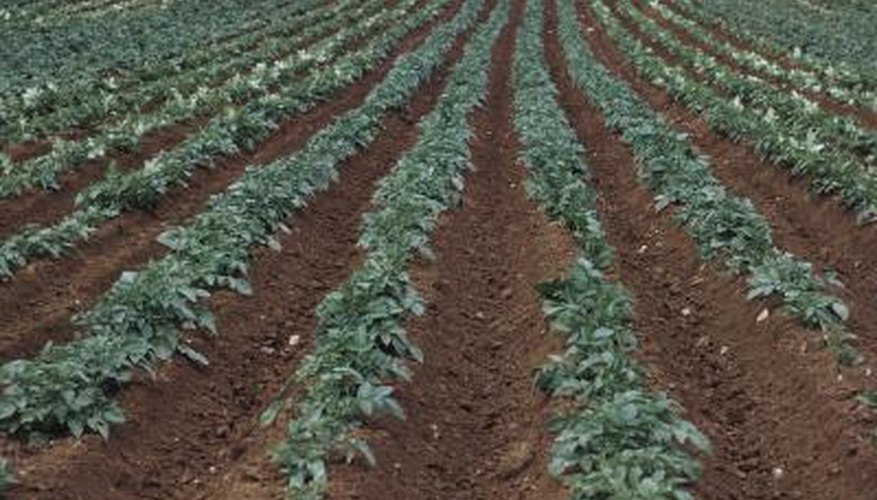Although called seed potatoes, you don't sow potato seeds. Seed potatoes are small root tubers with numerous buds called eyes. Once the garden soil warms to about 10 degrees Celsius in spring, plant seed potatoes in shallow furrow basins, called hills, or in long rows. Numerous fungal diseases potentially destroy seed potatoes, especially once planted in the cool, dark, moist conditions underground. Discard mouldy seed potatoes; do not plant them as they already contain at least one pathogen.
Certified Seed Potatoes
While it's possible to used leftover potatoes from last year's fall harvest for seed potatoes in spring, it's not a wise practice. Various pathogens, including fungal and mould spores, are invisible to the human eye and may exist on or within potatoes. Garden centres typically sell certified seed potatoes. This designation ensures the potato variety is pure and legitimate, and the seed potatoes have been treated to eliminate pathogens or greatly reduce their numbers in the potatoes prior to planting. Always inspect the certified product, as rot and mould may still arise during storage.
- While it's possible to used leftover potatoes from last year's fall harvest for seed potatoes in spring, it's not a wise practice.
- This designation ensures the potato variety is pure and legitimate, and the seed potatoes have been treated to eliminate pathogens or greatly reduce their numbers in the potatoes prior to planting.
Selecting Seed Potatoes to Plant
Feel the seed potatoes prior to planting them in the ground. Each should feel firm and dry with no mushy soft spots, mould, black crusting cankers or other strange skin. Any diseased seed potato will further rot or decay once in the ground. Any diseased seed potato, such as one harbouring mould, is prime to spread itself through the soil and infest nearby seed potatoes. If uncertain about the look or feel of a seed potato, discard it rather than planting it, as it may destroy the entire plant crop with an untreatable soil infestation.
- Feel the seed potatoes prior to planting them in the ground.
- Any diseased seed potato, such as one harbouring mould, is prime to spread itself through the soil and infest nearby seed potatoes.
Cutting Seed Potatoes
Seed potatoes possess at least one growing bud or eye, often two or three. If the mouldy seed potato shows mould only in one small localised area, you may still use the potato after cutting away the bad area. As long as the remaining portion of the seed potato contains at least one eye, it will develop into a plant. Cut away the moulded portion of the potato with a sharp, sterile paring knife. Sterilise the cutting blade in rubbing alcohol immediately. Let the cut seed potato air dry for 24 hours before planting so a callus seals the wound.
- Seed potatoes possess at least one growing bud or eye, often two or three.
- Let the cut seed potato air dry for 24 hours before planting so a callus seals the wound.
Planting Tips
Handle seed potatoes gently as any bruising potentially leads to softening and the entrance of a disease into the plant. Plant potatoes in a moist but well-drained soil. Soggy, heavy-textured soils encourage diseases and rot. The faster the seed potatoes sprout, the less chance of crop failure, according to North Dakota State University. Plant the seed potatoes shallowly, covered with only 1 to 2 inches of soil. Mound soil atop the sprouting plant in increments to promote more rooting and stem branching to more tubers for harvest.
- Handle seed potatoes gently as any bruising potentially leads to softening and the entrance of a disease into the plant.
- Plant the seed potatoes shallowly, covered with only 1 to 2 inches of soil.
